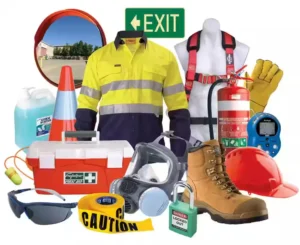Introduction
In industries where electricity is a constant presence such as power plants, electrical maintenance, and construction sites, the risks are significantly higher. One of the most critical protective gears for professionals in these environments is the safety helmet. Designed to shield workers from electrical shocks, falling objects, and accidental head impacts, the right helmet can be the difference between life and death. Yet, choosing the correct type requires more than picking a hard hat off the shelf; it involves understanding industry standards, material quality, and compatibility with other protective gear like safety gloves.
With numerous options available, knowing what to look for is vital. This blog provides a detailed guide to help you select the right safety helmet specifically for electrical work.
Key Features to Consider in a Safety Helmet for Electrical Work
When working in high-risk electrical environments, not just any helmet will suffice. You need one that is specifically designed for insulation and tested to meet rigorous safety standards. Here are the most important features to look out for:
1. Electrical Insulation Rating
Safety helmets used in electrical work are categorized into three main classes:
- Class G (General): Protects against low-voltage electrical conductors up to 2,200 volts.
- Class E (Electrical): Offers protection up to 20,000 volts, making it ideal for electricians and linemen.
- Class C (Conductive): Provides no electrical protection and should be avoided for electrical work.
For most electrical tasks, Class E helmets are the safest choice, ensuring strong insulation against high-voltage hazards.
2. Material Strength and Durability
The material of the helmet plays a vital role in both impact resistance and insulation. Helmets are commonly made from:
- Polycarbonate (PC): Lightweight, durable, and resistant to heat.
- High-Density Polyethylene (HDPE): Offers excellent impact resistance at a lower cost.
- Fiberglass: Extremely strong and resistant to heat but slightly heavier.
Electrical workers should prioritize helmets made from non-conductive materials that meet ANSI, ISI, or EN standards.
3. Comfort and Fit
A safety helmet worn for long shifts should not cause discomfort. Look for adjustable suspension systems, cushioned sweatbands, and ventilation options. Comfort features reduce fatigue and increase compliance among workers, ensuring helmets are consistently worn throughout the day.
4. Compatibility with Other PPE
In electrical environments, helmets often need to be paired with accessories such as face shields, ear protection, or arc flash visors. Choosing a helmet compatible with these add-ons ensures comprehensive safety. Additionally, workers should pair helmets with high-quality safety gloves for maximum protection when handling live equipment.
5. Chin Straps and Secure Fit
A helmet is only effective if it stays on the head during unexpected incidents. Helmets with durable chin straps prevent accidental slips or falls, especially for workers operating at heights.
Best Practices for Selecting and Maintaining a Safety Helmet
Even the most advanced safety helmet will not provide full protection if it is not used or maintained correctly. Below are some essential practices to follow:
1. Understand Workplace Hazards
Before purchasing helmets, conduct a workplace risk assessment. Are workers exposed to high-voltage lines, falling objects, or extreme weather? The answers will determine whether you need helmets with additional features like arc flash protection or UV resistance.
2. Ensure Compliance with Standards
Always check that the helmet complies with recognized safety standards such as:
- ANSI Z89.1 (U.S.)
- EN 397 (Europe)
- IS 2925 (India)
Certified helmets guarantee that they have undergone rigorous testing for electrical resistance, impact absorption, and flame resistance.
3. Regular Inspection and Replacement
Helmets are not designed to last forever. Exposure to sunlight, heat, or electrical discharges can weaken the material over time. Inspect helmets for cracks, dents, or fading colors regularly. Replace them every 3–5 years or sooner if they suffer visible damage.
4. Training Workers on Proper Use
Even the best helmets are useless if worn incorrectly. Workers should be trained on adjusting the suspension system, fastening chin straps, and identifying when a helmet needs replacement. Creating a culture of safety ensures helmets are worn consistently and correctly.
5. Hygiene and Comfort Maintenance
Sweatbands, padding, and straps should be cleaned regularly to prevent discomfort or hygiene issues. Many modern helmets come with replaceable liners, making maintenance easier and extending usability.
Common Mistakes to Avoid When Choosing a Helmet
Many accidents occur because of poorly chosen or misused helmets. Avoid these mistakes:
- Choosing the wrong class of helmet: Using Class C helmets around electrical equipment is a major hazard.
- Ignoring fit and comfort: A helmet that doesn’t fit properly is less likely to be worn consistently.
- Neglecting maintenance: Damaged or expired helmets reduce safety levels drastically.
Not pairing with other PPE: Helmets are most effective when used alongside other protective equipment like visors and safety gloves.
Conclusion
Safety helmets are a critical part of electrical and power industry workplaces, offering protection against both electrical and physical hazards. Selecting the right helmet involves more than just picking one that looks sturdy, it requires attention to insulation ratings, compliance with international standards, and long-term comfort for workers. When paired with complementary PPE such as safety gloves, helmets create a strong defense system against workplace dangers.
In high-risk environments, prevention is always better than cure. By investing in the right helmet and ensuring proper training and maintenance, companies can significantly reduce workplace accidents and protect their most valuable resource, i.e. their workers.




